constituent assembly of india debates (proceedings)- volume vii
constituent assembly of india debates (proceedings)- volume vii
constituent assembly of india debates (proceedings)- volume vii
Create successful ePaper yourself
Turn your PDF publications into a flip-book with our unique Google optimized e-Paper software.
2. Coming to the actual recommendations made by the two Sub-Committees, we are <strong>of</strong> the view that<br />
although certain features are common to all these areas, yet the circumstances <strong>of</strong> the Assam Hill<br />
Districts are so different that radically different proposals have to be made for the areas <strong>of</strong> this Province.<br />
The distinguishing feature <strong>of</strong> the Assam Hills and Frontier Tracts is the fact that they are divided into<br />
fairly large districts inhabited by single tribes or fairly homogenous groups <strong>of</strong> tribes with highly<br />
democratic and mutually exclusive tribal organisation and with very little <strong>of</strong> the plains leaven which is so<br />
common a feature <strong>of</strong> the corresponding areas, particularly the partially excluded areas <strong>of</strong> other<br />
Provinces. The Assam Hill Districts contain as a rule, upwards <strong>of</strong> 90 per cent <strong>of</strong> tribal population whereas,<br />
unless we isolate small areas, this is generally not the case in the other Provinces. The tribal population<br />
in the other Provinces has moreover assimilated to a considerable extent the life and ways <strong>of</strong> the plains<br />
people and tribal organisations have in many places completely disintegrated. Another feature is that<br />
some <strong>of</strong> the areas in Assam like the Khasi Hills or the Lushai Hills, show greater potentialities for quick<br />
progress than tribes in the other Provinces. They may also be distinguished by their greater eagerness<br />
for reform in which they have a dominant share than the apathy shown by the tribals <strong>of</strong> some other<br />
Provinces. Having been excluded totally from ministerial jurisdiction and secluded also from the rest <strong>of</strong><br />
the Province by the Inner Line system, a parallel to which is not to be found in any other part <strong>of</strong> India,<br />
the excluded areas have been mostly anthropological specimens; and these circumstances together with<br />
the policy <strong>of</strong> <strong>of</strong>ficials who have hitherto been in charge <strong>of</strong> the tracts have produced an atmosphere which<br />
is not to be found elsewhere. It is in these conditions that proposals have been made for the<br />
establishment <strong>of</strong> special local councils which in their separate hill domains will carry on the<br />
administration <strong>of</strong> tribal law and control the utilisation <strong>of</strong> the village land and forest. As regards the<br />
features common to tribal areas in other Provinces, the Assam hill man is as much in need <strong>of</strong> protection<br />
for his land as his brother in other Provinces. He shares the backwardness <strong>of</strong> his tract and in some parts<br />
the degree <strong>of</strong> illiteracy and lack <strong>of</strong> facilities for education, medical aid and communications. Provision is<br />
necessary for the development <strong>of</strong> the hill tracts in all these matters and we have found it necessary to<br />
recommend constitutional safeguards <strong>of</strong> various kinds.<br />
3. The differences between Assam and other areas as well as certain common features have been<br />
indicated above. While in Assam the Hill Districts present features <strong>of</strong> their own and the Assam Sub-<br />
Committee have confined their recommendations on the whole to these tracts, it has not been possible<br />
for the other Sub-Committee to deal with the problems <strong>of</strong> the tribes in exactly the same manner. The<br />
special features <strong>of</strong> the hills have been mentioned and they distinguish almost to the same degree the<br />
tribesmen in the hill and the tribesmen in the plains <strong>of</strong> Assam as they do the regular plains inhabitants.<br />
The total population censussed as tribal in the plains <strong>of</strong> Assam is about 1:5 million out <strong>of</strong> which possibly<br />
some 50 per cent. consists <strong>of</strong> tea-garden labour, drawn in part from other provinces. This portion <strong>of</strong> the<br />
plains tribals is <strong>of</strong> course a population which has assimilated in high degree the life <strong>of</strong> the plains. The<br />
stable population <strong>of</strong> plains tribals is more or less in the same position. As regards other Provinces, the<br />
degree <strong>of</strong> assimilation is on the whole greater whether the tribesman is found in the hills or in the more<br />
accessible parts although some <strong>of</strong> the small tribes in the Agency Tracts <strong>of</strong> Orissa and Madras have hardly<br />
come into contact with the plains. In any case their outlook is totally different. From the very manner in<br />
which partially excluded areas have been formed it has not been possible to include large numbers <strong>of</strong><br />
tribals who are scattered about in the Provinces irrespective <strong>of</strong> whether their condition was advanced or<br />
otherwise. It has been necessary therefore to treat all persons <strong>of</strong> tribal origin as a single minority and<br />
not separately as in the case <strong>of</strong> Assam. In this method <strong>of</strong> treatment therefore the recommendations for<br />
other Provinces differ radically from the proposals for Assam. The excluded and partially excluded areas<br />
however contain considerable concentrations <strong>of</strong> tribes people and generally they are in hilly and<br />
comparatively inaccessible areas with no communications and facilities for the development <strong>of</strong> the<br />
population. Land for them also is a vital factor and protection <strong>of</strong> the tribals' land is an essential need. The<br />
financial requirements <strong>of</strong> the Scheduled Areas are considerable, and the Centre will have to come to the<br />
assistance <strong>of</strong> certain Provinces at any rate. Thus the essential features <strong>of</strong> the proposals for the tribals <strong>of</strong><br />
Provinces other than Assam are proportionate representation for the tribals as a whole in the Legislature,<br />
the scheduling <strong>of</strong> certain areas as in need <strong>of</strong> special attention and in which the protection <strong>of</strong> land and the<br />
social organisation <strong>of</strong> the tribals is an indispensable need. To facilitate the proper administration <strong>of</strong> the


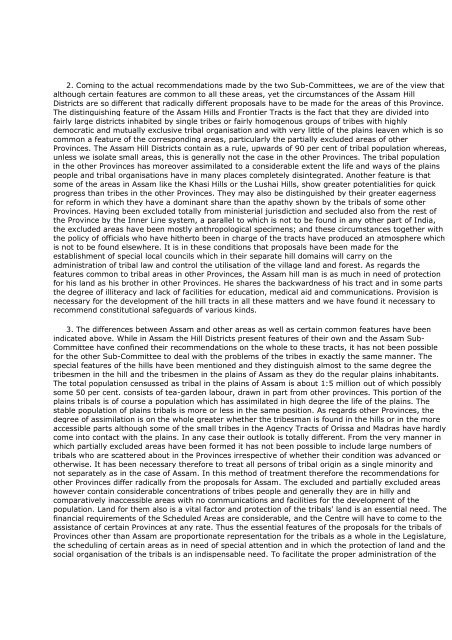
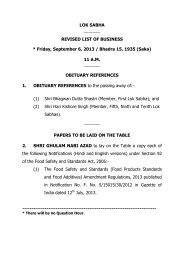
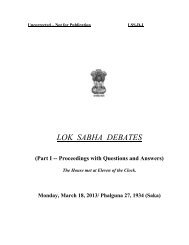

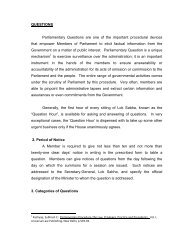
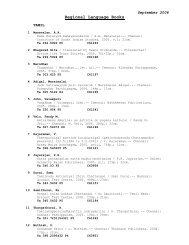

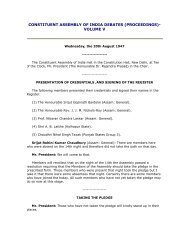
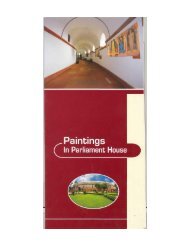
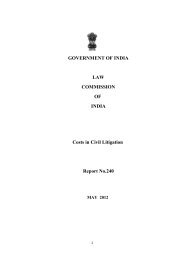
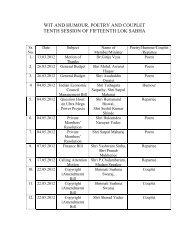
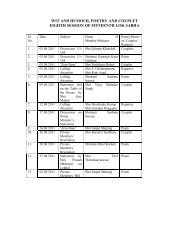

![gÉÉŌ A.]ÉŌ. xÉÉxÉÉ](https://img.yumpu.com/8015720/1/190x245/geeo-aeo-xeexee.jpg?quality=85)
